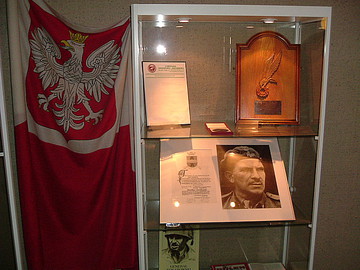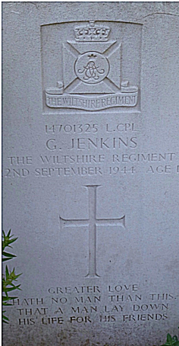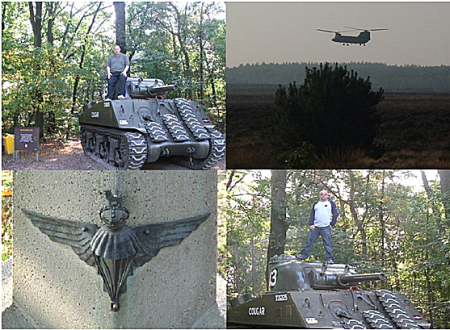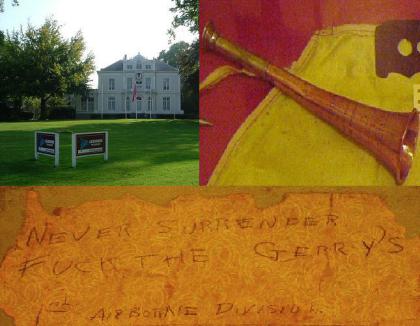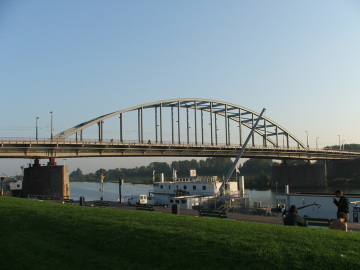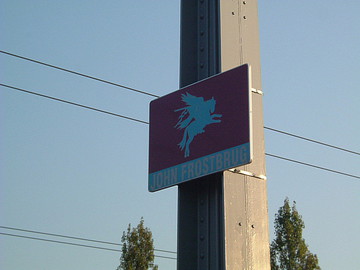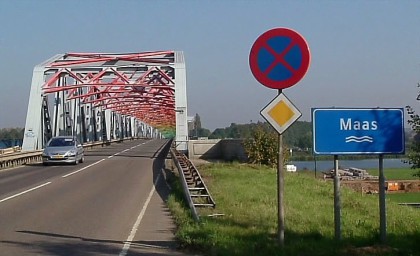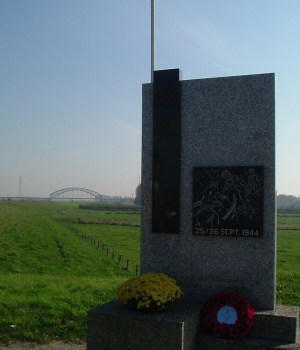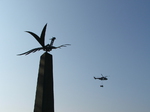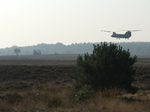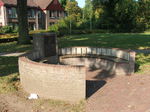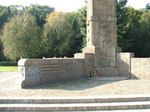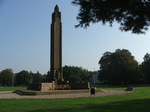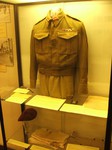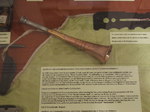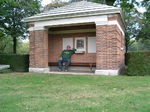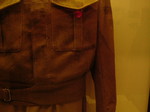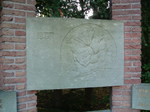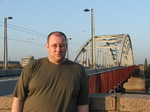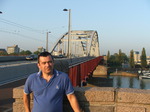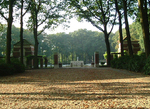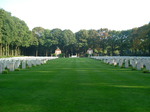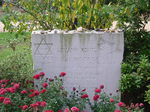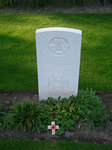
Market Garden
The Final Part of the Market Garden Tour
After the Battle of Varusschlacht trip,
it was back to what we know best and 20th Century warfare and the final touches of Operation Market Garden. First up was Elst and a small little dedication in Elst’s Town Hall to
General Sosabowski, who was made famous to non-war buffs by being played Gene Hackman in A Bridge Too Far.
The Polish 1st Independent Parachute Brigade was included among the Allied forces taking part in Operation Market
Garden. Due to a critical shortage of transport aircraft,
the brigade was split into several parts before entering the battle. A small part of the brigade with Sosabowski was dropped near Driel
on 19 September, but it was not until 21 September when the rest of the brigade finally
arrived in the distant town of Grave, falling directly into the waiting guns of the Germans camped out around the area.
The Brigade's artillery was dropped together with the British 1st Airborne Division and the howitzers were to arrive by sea transport. This prevented the Polish forces from being used effectively. Three times Poles under Sosabowski tried to force the Rhine crossing in order to help the surrounded 1st Airborne. However, the ferry they planned to use to reach the British had been sunk and Poles attempted the river crossing in small rubber boats under heavy fire. Nevertheless, at least 200 men succeeded in crossing and reinforcing the embattled British. Despite the difficult situation on the front, during a 24 September staff meeting, Sosabowski suggested that the battle could have still been won.
He suggested that the combined forces of 30th Corps and the Polish Brigade should start an all-out assault on the German positions and try to break through the Rhine. This plan was not accepted, and during the last phase of the battle, on 25 and 26 September, Sosabowski led his men southwards and shielded the retreat of remnants of the 1st Airborne. The rate of casualties among the Polish units that fought in the battle was high, in some cases as high as 40%. At least in part, the heavy casualties were the result of Browning's decision to drop the paratroops into a position located 7 kilometres from the bridge. After the battle, on 5 October 1944, Sosabowski received a letter from Montgomery, where he described Polish soldiers as fighting bravely and offered Sosabowski to award 10 of his soldiers.
On 14 October 1944, Montgomery wrote another letter, this time to British commanders, where he made Sosabowski a scapegoat for the failure of Operation Market Garden. Sosabowski was accused of criticising Field Marshal Montgomery and the Polish General Staff was forced to remove him as the commanding officer of his brigade on 27 December 1944. He was made the commander of guard troops and in July 1948 he was demobilised. Shortly after the war Sosabowski managed to bring his only son and his wife from Poland.
Like many other Polish wartime leaders and soldiers exiled from communist Poland he settled down working in West London. He found a job as a factory worker in the CAV Electrics assembly plant in Acton. He died in London on 25 September 1967. It has been suggested that friends and associates with whom he lived and worked in England were largely unaware of his military accomplishments until they attended his funeral, at which his full rank and achievements were read out.
In 1969 his remains were interred in the Powązki Military Cemetery in Warsaw, Poland. Although wrongly criticised by the British, it is pleasing to see that Elst and the nearby town of Driel (See later) remember both this remarkable soldier and The Polish 1st Independent Parachute Brigade. I cannot see the official reason why, but it is clearly deserved that he was made a CBE, so some possible recognition by the British for Major General Stanisław Franciszek Sosabowski, CBE and Freeman of the Municipality of Heteren.
We were now closing in on Arnhem, and we aimed to go to an odd museum at Heteren. The Betuws museum covers information on “The Island”. The Island relates to a flat agricultural area, below sea level. Dikes that were 7 meters high and wide enough at the top for two-lane roads held back the flood waters.
The area in which it fought was a 5-kilometer-wide "island" that lay between the Lower Rhine on the north and the Waal River on the south. The cities of Arnhem, on the Lower Rhine, and Nijmegen, on the Waal. This was seen in the episode of Band of Brothers called “Crossroads”. We had plans for the museum but when we got there it was closed, it does have odd opening hours so please check the website www.betuwsoorlogsmuseum.nl or email them to avoid disappointment - info@betuwsoorlogsmuseum.nl
My Sister, Joanne had a relative (on a different side of the family to mine) who fought and died. He was called Glyn (Glyndwr) Jenkins. He was a Lance Corporal with the 4th Battalion of the Wiltshire regiment. He was killed at Valburg, just north of Nijmegen-Netherlands and according to the book, “The Maroon Square” (4th Wilts in NW Europe 1939-1946), at that time, during the “Battle for The Island”, The 4th Wilts was trying to break through to Elst in order to reach the 1st Airborne Division perimeter north of the Rhine.
Unfortunately this was to no avail. His final grave in Bergen op Zoom War Cemetery, some considerable distance away may be explained by the fact that after the War, they may have exhumed Glyn’s remains from his Valburg field grave and transferred them to the newly established Bergen op Zoom War Cemetery, some 80 miles to the SW. The same goes for two other members of Glyn’s regiment in the Wiltshire’s - Privates G. Vile and P.A. White who were also killed at Valburg. I visited Glyn's grave on behalf of Joanne during the Dambusters trip in 2012.
We became excited when we reached Ede. Ede has a Sherman tank and Kevin, especially loves a good tank, as much as he likes a good plane. The Tank at Ede stands at the three main roads into to Arnhem and the inscription on the tank says - "Liberation Ede, On 17 April 1945, the Village of Ede was Liberated by the Canadian Calgary Regiment with Sherman Tanks.
This Unit was part of the British “Polar Bear” Regiment. After taking various “Cool” pictures of us on the tank we wandered up to Ginkel Heath. Ginkel Heath was Drop Zone Y. Furthest from Arnhem and the Bridge, 4th Para Brigade (10, 11 and 156 Bn’s plus supporting arms) landed around here on 18th September: the area having been secured and fought on by 7th KOSB.There is a low stone inscribed “Luchtlanding 17-18 September 1944” and a much larger wonderful pillar style memorial rising up.
Badges of the Airborne, Pegasus and Kings Own Scottish Borderers are mounted on it. Near the base is the plaque inscribed “...they shall mount up with wings” It is here that every year in September a commemorative Parachute drop is held, with Veterans still returning. I guess in September 2014, it will be the possible last ever drop by veterans as it will be the 70th Anniversary. Kevin and I are hoping to attend on behalf of the NMBS. Ginkel heath is still used today by the Dutch Army as you can see from our pictures below.
We then drove to The Culvert, which perhaps was one of the bravest and ingenious aspects of the Arnhem battle. On the north side of the railway in Wolfheze lies the
Johannoeveweg,
an unmade road, leading west toward Arnhem. It was along here that Major Freddie Gough’s ill fated “coup de main” recce troop set off for the bridge. Mounted in their Jeeps, they were ambushed near
the A50 over-bridge and suffered heavily. The German SS “Krafft Battalion” attacked with machine guns and flamethrowers.
On 18th September 1944 in the trees north of the culvert Captain Lionel Queripel earned the VC. He fought a rearguard action with pistol and grenades; the award was given posthumously. The
culvert tunnel under the railway embankment was built for drainage and not traffic. However, during the battle elements of 4 Para Brigade retreated through the tunnel even with their Jeeps, having to
let air out the tyres and lower the windscreens.
Close to the Culvert is the village of Wolfheze, Scene of perhaps one of the more memorable bits in a truly great film – A Bridge Too Far, where after bombardment of the close by Psychiatric Hospital, Major General Urquhart, played by Sean Connery is somewhat aghast as his Corporal played by Colin Farrell (no not that one!) offers him a “Typical British Cup of Tea” and Urquhart says “Hancock. I've got lunatics laughing at me from the woods. My original plan has been scuppered now that the jeeps haven't arrived. My communications are completely broken down. Do you really believe any of that can be helped by a cup of tea?” The is a hospital still there when we went in 2005 and some of the patients were wandering about the area.
When we were there we had a cuppa at a Cafe and tried some local Dutch food after we asked the Lady who served us for German sausages she cagouled us into trying Dutch delights. My god. I like food; I like to try anything from Snails to Locusts, Ostrich to Garlic Bread but I fear I will never try Dutch food again. It was like a bland cheapo Netto square sausage, surrounded by a cheap Dairylea cheese slice dipped in breadcrumbs and deep fried. To para-quote Connery/Urquhart “I've got lunatics laughing at me for eating the Dutch food!” We left and arrived at the Airborne Museum Hartenstein, in Oosterbeek.
It is a museum dedicated to the Battle of Arnhem, during the battle the building was the headquarters of the British forces fighting in and around Oosterbeek and Arnhem. The Museum shows a diverse and extensive collection of original weapons, uniforms and equipment, alongside interviews, pictures and videos about the battle. You can see from the pictures below John Frost's Bugle and a bit of Wallpaper with a somewhat fruity note from a British Soldier to the Germans. In addition to this collection, the museum has an award-winning Airborne Experience exhibition, which depicts the area as it appeared during the battle. The museum also describes the German and civilian perspectives of the battle. Shortly after the Second World War, plans were made to open a museum about the battle.
In 1949 a museum was opened in Doorwerth Castle near the Rhine. Soon it became evident that the castle was not big enough to display the growing collection and a better location was sought. The Hotel ‘Hartenstein’, which had resumed its role as a hotel after the war, was purchased for the role and on 11 May 1978, General-major Roy Urquhart officially opened the Airborne Museum ‘Hartenstein’ In 2008, the museum temporarily closed its doors in order to renovate and expand and a brand new lobby and basement were added to the building. The basement was used to display the new 'Airborne Experience', a series of dioramas of the battle. The display was awarded the Gouden Reiger (“The Golden Heron” Dutch awards for audience interactions), in the category three-dimensional media. The museum was reopened in September 2009, on the 65th anniversary of the Battle of Arnhem.
Each year the Airborne Museum ‘Hartenstein’ is involved in events commemorating the Battle of Arnhem. It also serves as a gathering place for veterans, civilians and young people. The museum is close to the Arnhem Oosterbeek War Cemetery where several hundred of the Allied casualties are buried. Every year the participants of the Airborne March pay a special tribute when the parade is held in front of the museum
Finally we reached our “Bridge Too Far” and The John Frost
Bridge (John Frostbrug) in Arnhem.
Arnhem, like so many cities in The Netherlands, France, Germany and obviously due to the Blitz in the UK has changed and its a modern industrial city.
The “final bridge” at Arnhem, the ultimate goal of Market Garden, was entrusted to General Roy Urquhart and his 1st British Airborne Division with the 1st Polish Independent Parachute Brigade under command. Urquhart and his 10,000 men were
to be dropped 60 miles into enemy territory, and it would be 3 days before British tanks reinforced them.
Overwhelming though this colossal assault was, it was also equally flawed. Airborne troops are only lightly armed and their survival depends upon taking the enemy by surprise and reaching objectives
before they have time to react with heavy weapons.
However, so cocksure were the Allies in their view that the Germans were already beaten; numerous grave errors were made which doomed Market Garden to failure before a shot had been fired.
Principally, there were not enough transport planes to fly all three Divisions to their targets in one go.
Instead they had to be flown to Holland in three lifts, with only one lift per day. As a result, only half of the 1st Airborne were flown to Arnhem on the first day. Also, due to the
unsuitability of the ground in the area, they were dropped a massive 8 miles from the bridge.
It was not anticipated that this would prove a problem as immediate opposition was believed to be light, however by a complete fluke, two elite German SS Panzer Divisions had recently been billeted
in and around the town. These units were well trained, fresh from battle, and were equipped with tanks.
The prized Arnhem Bridge for which the British had fought so hard did not survive the war. As the front line stabilised south of the Rhine, B-26
Marauders of 344th Bomb
Group, USAAF destroyed it on 7 October to deny
its use to the Germans.
It was replaced with a bridge of similar appearance in 1948 and renamed John Frost Bridge on 17 December 1977.
A tragic consequence of the operation's failure was the Hongerwinter (Hunger winter). During the battle Dutch railway workers, incited by the Dutch government in London, went on strike in order to aid the
Allied assault. In retribution Germany forbade food transportation, and in the following winter more than twenty thousand Dutch citizens starved to death.
The final days we spent mopping up the places that we wanted
to tick off our lists before we headed back to Köln and our last night stay there.
Again in a reference to the film A Bridge Too Far we found the Waal crossing. This is where Major Julian Aaron Cook portrayed by Robert Redford crossed the Waal in flimsy boats chanting “Hail
Mary”.
On September 17, 1944, Major Cook jumped into Holland near the Maas-Waal Canal. After assisting in securing the canal crossing, his unit marched to Nijmegen. General
Gavin had ordered a crossing of the Waal
River during daylight hours so the Americans could outflank the German defenders, who were dug in around the city’s crucial bridges. Cook was put in charge of the crossing, was in the first wave
across the river. As Cook’s first wave began their crossing, the allied bombardment began. The wind blew away the smokescreen, leaving the men in the water open and visible to the German guns. As a
devout Catholic, Cook loudly recited Hail Mary during the crossing, spurring his men on under the withering fire.
He took charge of the boats, redirecting those who were disoriented and pushing the men along. Once ashore, the Parachute Infantry Regiment cleared the river bank and assaulted the highway bridge.
The 3rd Battalion, 504th PIR finally captured the bridge at 1900 hours. The 504th sustained over 50% casualties (approximately 25% casualties crossing the canal and another 25% casualties taking
the northern end of the Waal River Bridge). To add perspective to this heroic action, it is interesting to note that the Light Brigade at Balaclava sustained 40% casualties, and General George
Pickett's Division at Gettysburg sustained 60% casualties in its charge against Union forces at Cemetery Ridge.
The difference between the 504th's action and those of the Light Brigade and Pickett's Division is that the 504th accomplished its mission despite taking similar horrific casualties. In his book, A
Bridge Too Far, author Cornelius Ryan cites sources who describe this action as "...a second Omaha Beach landing" Because of the bloodiness of the assault.
After leaving the site of the crossing we headed to Driel, as mentioned earlier and the connection with The Poles and Major
General Sosabowski. We also paid our respects at the memorial to the Royal Engineers, Hampshire and Duke of Cornwall Regiments who have memorials there. Close by is the Heveadorp ferry had,
which had been destroyed during Market Garden, but still runs today and seeing it was there it would have been rude not to have a go.
The Crossing only takes a few minutes, but it’s a rather pleasant few minutes, and Gerry does like his boats.
Finally we saw one of the last of the Bridges at Grave, today it is multi-coloured (Like a Giant Rainbow - look close at the picture below) and some would say a groovy looking bridge. It
is the northern connection to Gelderland (Which is my maternal homeland, I am of Dutch stock and the family name is Gelder), spanning the river Maas. The city of Grave was
liberated at 17 September 1944, but suffered very little damage. The bridge was named in 2004 after Lieutenant John S.
Thompson who commanded the platoon of
the 82nd Airborne Division that conquered the bridge.
After visits to a few CWGC sites we found perhaps one of the coolest but unusual memorials at Overasselt – The Memorial to the 325th US Glider Infantry, Three “Antony Gormley-esque” Statues in the
form of parachutes.
The last night at The Ponderosa was upon us and Gerry’s famous Colcannon went down a treat. We packed the next morning, bidding goodbye to Berg en Dal until 2012, when we popped back. One
final chill out night in Köln before Kevin left us to rejoin his coach marathon across Europe, where the smartest of the group flew home.
The next tour was soon decided. The First World War beckoned again and the most infamous town connected to that war where the British fought was to be the next trip.
